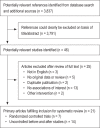Effectiveness of lifestyle interventions on obstructive sleep apnea (OSA): systematic review and meta-analysis
- PMID: 24082315
- PMCID: PMC3773205
- DOI: 10.5665/sleep.3056
Effectiveness of lifestyle interventions on obstructive sleep apnea (OSA): systematic review and meta-analysis
Abstract
Background: Obstructive sleep apnea (OSA) is a common sleep disorder associated with several adverse health outcomes. Given the close association between OSA and obesity, lifestyle and dietary interventions are commonly recommended to patients, but the evidence for their impact on OSA has not been systematically examined.
Objectives: To conduct a systematic review and meta-analysis to assess the impact of weight loss through diet and physical activity on measures of OSA: apnea-hypopnea index (AHI) and oxygen desaturation index of 4% (ODI4).
Methods: A systematic search was performed to identify publications using Medline (1948-2011 week 40), EMBASE (from 1988-2011 week 40), and CINAHL (from 1982-2011 week 40). The inverse variance method was used to weight studies and the random effects model was used to analyze data.
Results: Seven randomized controlled trials (519 participants) showed that weight reduction programs were associated with a decrease in AHI (-6.04 events/h [95% confidence interval -11.18, -0.90]) with substantial heterogeneity between studies (I(2) = 86%). Nine uncontrolled before-after studies (250 participants) showed a significant decrease in AHI (-12.26 events/h [95% confidence interval -18.51, -6.02]). Four uncontrolled before-after studies (97 participants) with ODI4 as outcome also showed a significant decrease in ODI4 (-18.91 episodes/h [95% confidence interval -23.40, -14.43]).
Conclusions: Published evidence suggests that weight loss through lifestyle and dietary interventions results in improvements in obstructive sleep apnea parameters, but is insufficient to normalize them. The changes in obstructive sleep apnea parameters could, however, be clinically relevant in some patients by reducing obstructive sleep apnea severity. These promising preliminary results need confirmation through larger randomized studies including more intensive weight loss approaches.
Keywords: Lifestyle Intervention; meta-analysis; obesity; obstructive sleep apnea; systematic review.
Figures








Comment in
-
Evaluating behavioral weight loss programs for sleep apnea.Sleep. 2013 Oct 1;36(10):1419-20. doi: 10.5665/sleep.3026. Sleep. 2013. PMID: 24082300 Free PMC article. No abstract available.
-
Lifestyle changes aiming at weight loss should always be included in the treatment of obese patients with obstructive sleep apnea.Sleep. 2014 May 1;37(5):1021. doi: 10.5665/sleep.3682. Sleep. 2014. PMID: 24790281 Free PMC article. No abstract available.
References
-
- Young T, Peppard PE, Taheri S. Excess weight and sleep-disordered breathing. J Appl Physiol. 2005;99:1592–9. - PubMed
-
- Somers VK, White DP, Amin R, et al. Sleep apnea and cardiovascular disease: an American Heart Association/American College of Cardiology Foundation Scientific Statement from the American Heart Association Council for High Blood Pressure Research Professional Education Committee, Council on Clinical Cardiology, Stroke Council, and Council on Cardiovascular Nursing. J Am Coll Cardiol. 2008;52:686–717. - PubMed
-
- Tasali E, Ip MS. Obstructive sleep apnea and metabolic syndrome: alterations in glucose metabolism and inflammation. Proc Am Thorac Soc. 2008;5:207–17. - PubMed
-
- Young T, Skatrud J, Peppard PE. Risk factors for obstructive sleep apnea in adults. JAMA. 2004;291:2013–6. - PubMed
Publication types
MeSH terms
Grants and funding
LinkOut - more resources
Full Text Sources
Other Literature Sources

